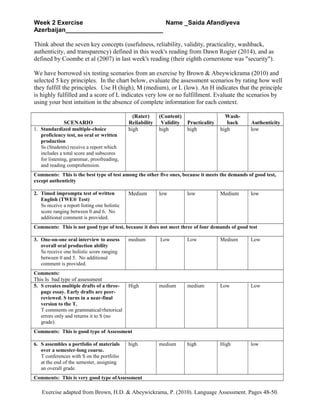
Evaluating language assessment scenarios
- 1. Week 2 Exercise Name _Saida Afandiyeva Azerbaijan____________________________ Think about the seven key concepts (usefulness, reliability, validity, practicality, washback, authenticity, and transparency) defined in this week's reading from Dawn Rogier (2014), and as defined by Coombe et al (2007) in last week's reading (their eighth cornerstone was "security"). We have borrowed six testing scenarios from an exercise by Brown & Abeywickrama (2010) and selected 5 key principles. In the chart below, evaluate the assessment scenarios by rating how well they fulfill the principles. Use H (high), M (medium), or L (low). An H indicates that the principle is highly fulfilled and a score of L indicates very low or no fulfillment. Evaluate the scenarios by using your best intuition in the absence of complete information for each context. SCENARIO (Rater) Reliability (Content) Validity Practicality Wash- back Authenticity 1. Standardized multiple-choice proficiency test, no oral or written production Ss (Students) receive a report which includes a total score and subscores for listening, grammar, proofreading, and reading comprehension. high high high high low Comments: This is the best type of test among the other five ones, because it meets the demands of good test, except authenticity 2. Timed impromptu test of written English (TWE® Test) Ss receive a report listing one holistic score ranging between 0 and 6. No additional comment is provided. Medium low low Medium low Comments: This is not good type of test, because it does not meet three of four demands of good test 3. One-on-one oral interview to assess overall oral production ability Ss receive one holistic score ranging between 0 and 5. No additional comment is provided. medium Low Low Medium Low Comments: This Is bad type of assessment 5. S creates multiple drafts of a three- page essay. Early drafts are peer- reviewed. S turns in a near-final version to the T. T comments on grammatical/rhetorical errors only and returns it to S (no grade). High medium medium Low Low Comments: This is good type of Assessment 6. S assembles a portfolio of materials over a semester-long course. T conferences with S on the portfolio at the end of the semester, assigning an overall grade. high medium high High low Comments: This is very good type ofAssessment Exercise adapted from Brown, H.D. & Abeywickrama, P. (2010). Language Assessment. Pages 48-50.
- 2. Exercise adapted from Brown, H.D. & Abeywickrama, P. (2010). Language Assessment. Pages 48-50.